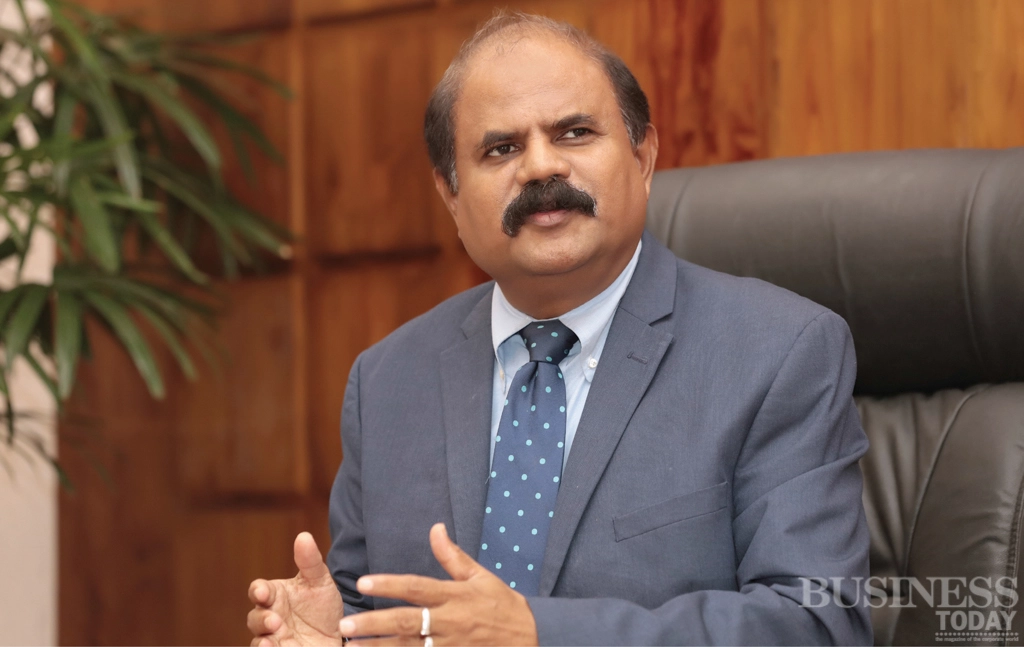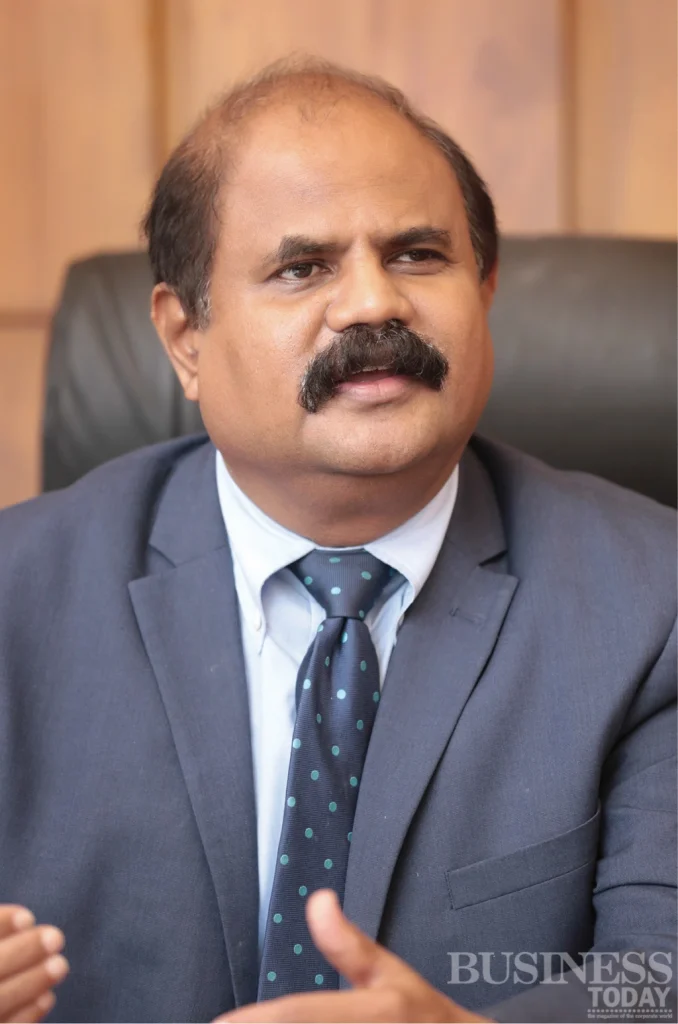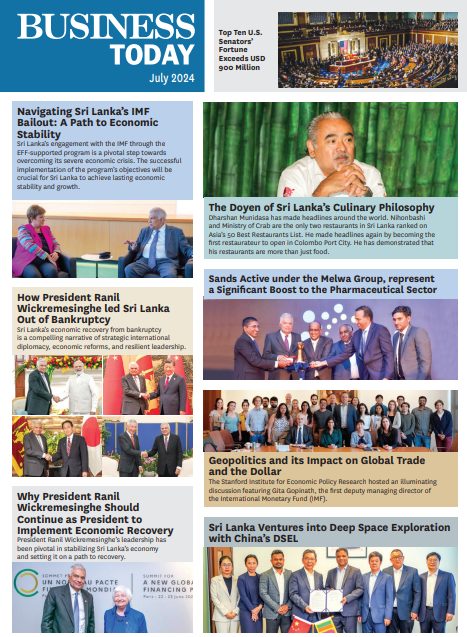
Sri Lanka Telecom (SLT) Group is a leader of integrated telecommunications in Sri Lanka and continues its iconic status in Sri Lanka as well as the South Asian region. The Group is among the top five companies with highest contribution to the national economy. At the dawn of a new era in the industry, SLT together with its wholly owned subsidiary Mobitel, are committed to enabling a digitised Sri Lanka. Through the i-Sri Lanka and 4G-LTE programmes, which will expand the broadband connectivity speeds in the country, SLT hopes to add to the growth of the national GDP. Hence, the Group envisages spearheading the emergence of Smart Cities, the Internet of Things (IoT) and Big Data in the country. P G Kumarasinghe Sirisena, Chairman, Sri Lanka Telecom (SLT) says that while sustaining their growth rate and doubling their revenue are key objectives, their main objective is to ensure the satisfaction of employees. With an all Sri Lankan team at the helm for the very first time of the telecommunication giant, he added, that SLT does not merely strive to be a leader in the industry, but to also perform their duty as the voice of the people’s aspirations.
By Udeshi Amarasinghe and Keshini De Silva
Photography Mahesh Bandara and Menaka Aravinda
Can you elaborate on the performance of the telecommunication giant in the recent past?
In the past three and half years, the revenue of Sri Lanka Telecom has been increasing year on year. In 2018, we expect SLT to record a revenue of 50 billion rupees and for Mobitel to record a revenue of 40 billion rupees; a total revenue of 90 billion rupees for the entire Group. We expect a growth of 13 per cent. We are extremely pleased that this year, especially in the first six months, we have been able to reach our targets. In terms of revenue growth, we have achieved beyond the targets in the Business Plan as we have worked towards projections beyond these targets.
What are the major milestones in terms of new products, services and facilities?
In the past three and half years, our main objective has been the deployment of high-speed fibre-optic connectivity, which commenced in 2013. In addition, we are also enhancing the capabilities of our copper connectivity in the country. These projects are part of our island-wide network modernisation initiative; i-Sri Lanka Programme. We commenced implementation in 2011, and the programme was completed in 2016. As a result, there is now a fibre-enabled (Fiber-to-the-Cabinet) copper connectivity capacity of 1.69 million with over 1.15 million active connections throughout the island. We have been already serving, fixed broadband internet exceeding 800,000 connections and IPTV (PEO TV) exceeding 350,000 connections to households and business locations. We have covered all 329 Divisional Secretariats in Sri lanka through a fibre-optic network spanning 35,000km. Sri Lanka has a population of 21.44 million, however there are only 5.6 million households. We have been able to deploy connectivity to 1.9 million through the fixed line services we offer including copper, fibre and 4G-LTE.
With Broadband Penetration Increasing By Ten Per Cent, The GDP Of A Country Is Expected To Increase By Two Per Cent, Which Means We Will Be Making A Significant Contribution To The Country.
Through our mobile arm we have achieved a reach of seven million customers. If we consider our population, we have therefore reached 66 percent of connectivity and market penetration by both companies. In terms of internet facility penetration, it is only at 22 percent. For Mobitel, the company’s highest investment in terms of expanding connectivity and implementing new technology was recorded in 2018, the last significant investment being in 2011. The current investment is 80 million US dollars.
In terms of SLT, by 2020 the broadband coverage will expand to 75 – 80 per cent of the households in Sri Lanka. Internationally, the increase in GDP is positively correlated with countrywide broadband connectivity. Hence, with broadband penetration increasing by ten per cent, the GDP of a country is expected to increase by two per cent, which means we will be making a significant contribution to the country. While Mobitel has made investments amounting to 15 billion rupees this year, SLT’s investments have been over 100 billion rupees for the past three and a half years. In addition to i-Sri Lanka network modernisation initiative, our projects include the launch of the Tier Three (T3) National Data Centre at Pitipana and SEA-ME-WE 5 submarine cable for global connectivity. At present, we have linked 850 state institutions to the Local Government Network (LGN) while another 3,000 need to be linked; we are well on the way to completing that project. In the coming years, we will launch initiatives to enable digital infrastructure facilities for all state schools and state hospitals, through fibre connectivity.
For SLT, 2018 will be a year where many milestones projects will be launched. Considering the amount of our investments, I believe we are amongst the top five companies in the country investing towards the betterment of Sri Lanka. These investments involve new products such as LTE (fixed wireless), PEO TV (IPTV), ADSL broadband and Fibre broadband (FTTH: fiber-to-the-home). That is for voice, data as well as entertainment services. One of our major challenges in the future as a nation is going through the inevitable digital transformation, and in order for the country to successfully achieve this, we need to have the required infrastructure in place. We have already done so, and it is time to see the results.
Moving forward what is the strategic direction of SLT and its associated companies?
There are nine companies in the Group. Apart from Mobitel and SLT, the others were not financially strong in their performance in 2015. However, we have been able to uplift all the Group’s subsidiaries and have enabled them to become profit-making entities. Recently, we acquired e-Channeling, which at the time of the purchase had its market share reduced to 20 per cent. Since our takeover, we have been able to increase this to over 50 per cent.
Complementing the country’s ICT transformation journey, SLT Group is committed to serve as a catalyst in establishing the communication backbone and required futuristic IT infrastructure, which in turn would become the foundation for virtually all other economic sectors. Our strategy drives us to monetise every asset of the Group and synergise operations as much as possible, in order to maximise returns and thereby increase Group value.
Moving Away From A Traditional Management Style, SLT Now Has Empowered Staff And Managers To Take Initiative And Build A Flourishing Digital Ecosystem.
Thus far, Sri Lanka Telecom has been a communications service provider, and our responsibilities were focused around this. We are however moving towards a transformation. Communications is not a lucrative revenue generating sector anymore, and our fixed voice income has reduced same as for telecom companies across developed nations. Our vision for 2018 is to move from a Communications Service Provider (CSP) to a Digital Service Provider (DSP), which is in line with the global trend. Through smart solutions such as e-education and e-medicine, society is constantly striving towards efficiency and optimisation of the available time. As such we too must move towards improve our productivity, which in turn will contribute to increase our GDP. We have created the road map with defined Key Performance Indicators (KPIs). While we have already achieved several KPIs, once we reach all our targets, we will be leading Sri Lanka to reap the benefits arising from the Internet of Things (IoT) and Big Data analytics.
SLT and Mobitel, along with the entire Group, is now working on synergising their visions. Moving away from a traditional management style, SLT now has empowered staff and managers to take initiative and build a flourishing digital ecosystem.
SLT is also a partner in development, can you elaborate on this?
SLT becomes a partner in the development of the nation by enabling the expansion of the country’s broadband connectivity, which in turn enables further growth in the national GDP due to the positive correlation between the two. Convenience, productivity and time savings will result in higher national GDP. For example, in the past, in order to obtain a birth, marriage or death certificate, one would have to visit many state institutions, which is a time consuming endeavour. Similarly, obtaining a national identity card and passport would take months. However, today, due to the connectivity enabled by SLT to all Government institutions we have been able to support better time management in the state sector. This includes making certain services accessible for Sri Lankans right at their fingertips. When people move towards obtaining digitized services, there is greater productivity, which will be reflected in the GDP in addition to other added benefits such as a reduction in traffic congestions.
The contribution to the Government either through taxes, dividends or spectrum charges for 2015 was 19 billion rupees, 2016 recorded 26 billion rupees and the contribution for 2017 was 39 billion rupees. This year our aim is to contribute over 40 billion rupees to the national economy. As such, we are one of the major corporates contributing to the national economy.
Can you tell us about the synergy between SLT, Mobitel and associated companies?
An integral part of SLT’s Vision 2022 is achieving complete Group synergy. Through different initiatives, the Group will combine all operations into one enterprise. Furthermore, it will include the streamlining of the internal structure, systems, and processes. Vision 2022 will position the SLT Group as a market leader with one face, one view across all integrated Group platforms.
Across The Globe, Fixed-Line And Mobile Providers Are Not Stringently Separated. However, In Sri Lanka This Is The Case, Making It Almost Impossible To Combine The Two Service Providers.
SLT has sole ownership of Mobitel through a 100 per cent investment of over 12 billion rupees. Any fixed line provider in the world requires a good mobile arm. The world is now geared towards mobile technological advancement. However, mobile technology requires connectivity. For example, over 2,500 mobile towers in Sri Lanka are now being connected through optical fibres and SLT has the mandate to deploy such infrastructure in the island. This will take place as a synergy between SLT and Mobitel, enabling greater capacity than microwave connections. Over the past three years we were able to obtain a new spectrum band for Mobitel to increase the broadband delivery. If anyone assess, they will find that the fastest mobile broadband connection in the country is from Mobitel. The TRC has displayed these reports on its website.
The more we empower Mobitel, the more the connectivity between the population of Sri Lanka can be synergised with SLT. The two companies are working together with synergy in a range of projects. For example, in the past Mobitel and SLT had different marketing plans and budgets, but today both service providers are marketed together. Activation and digital transformation are a few other aspects on which we collaborate. We have identified internal and external constraints for achieving synergy within the Group, and wherever possible we have begun to work with greater synergy and collaboration. Our goal is to achieve upwards of two billion rupees in savings through collaboration. The two company’s IP Multimedia Subsystem (IMS), Operation Supporting System (OSS), Business Supporting System (BSS) and Enterprise Resource Planning (ERP) System function separately at present. Once we are able to overcome certain restrictions, we will be able to collaborate further and provide benefits to our customers. For example, the investment for enabling ERP at SLT and Mobitel was 1,750 million rupees. If we implemented this separately, then the investment would have been twice as much. By collaborating on fibre connectivity we have been able to save more than one billion rupees.
In fact, across the globe, fixed-line and mobile providers are not stringently separated. However, in Sri Lanka this is the case, making it almost impossible to combine the two service providers. If not for these regulations, we would be able to reap greater benefits through collaboration.
What are your thoughts on the telecommunication industry in general in Sri Lanka?
The telecommunications industry today is extremely competitive. With the rapid advancement of technology operators must adapt quickly, or else one cannot survive in the industry. Due to the pace of technological change at times we are unable to even achieve the target return on investments before another technology has come to the foray. The customer constantly demands technology improvements, but it comes at a cost. If we are able to see quick returns on investments for the technology platforms we choose to invest, that is the best outcome for us. Only those who are able to take large risks invest in the telecommunications industry, resulting in less investment in this sector as time goes by.
In Sri Lanka, there are eight internet service providers in commercial operation; five are mobile service providers and three are fixed line service providers. The competition between these companies is fierce, and at times it is difficult for these service providers to see a return on certain investments. Return on investments is one of the greatest challenges to all service providers in the country. Hence, we too face the challenges predominant in the global industry. For example, there is a decrease in fixed line and mobile voice revenues globally as people are converting towards over-the-top (OTT) applications using data. However, Sri Lanka has the lowest data tariff in the entire world. We need a fair price for data services. Despite the increase in the usage of data services, benefits towards the industry are weak.
Our Goal Is To Achieve Digitization By 2020, And The Greatest Challenge To Our Journey Is Changing People’s Mindset.
If an industry does not see a return on investment, then it is difficult to sustain that industry. In the next three years, the industry has to make considerable investments to enable the country’s digital transformation. However, this is extremely risky from a business perspective. For example, we made an eight-billion rupee investment in SEA-ME-WE 5 submarine cable and Sri Lanka has become a key location in the optical fibre submarine communications cable system due to the island’s strategic positioning. However, we are yet to achieve economies of scale or ROI as the capacity caters to future demand. The recent National Data Centre too has been built with capacity for 500 racks, however we see the demand is not up to the level we expected and believe there will be a improvement in the trend. I am sure our competitors face similar obstacles in terms of the return on investments. Five players are running at a loss, and we are not pleased about this as they are required for the development of the country. However, the current business environment does not sustain smaller players. If we lose small players, one or two dominant players will emerge, resulting in negative repercussions for the country and customer.
SLT is a market leader, especially in terms of fixed-line, however our competitors closely follow us. The smaller players and competition is required in the industry for the benefit of the consumer. Considering SLT has a huge asset base, we do not receive adequate returns and profit. We are unable to do so due to issues in matching supply and demand and affordability challenges. After all, if the market cannot afford the price, we will be unable to sell the product. It is the case with fibre-connectivity, where in the world there is a huge demand for the service, yet in Sri Lanka many are still unable to bear the cost. In Sri Lanka we have free education, free health and to a greater degree free transportation, as a result there is a mentality of expecting goods and services for free.
Our goal is to achieve digitization by 2020, and the greatest challenge to our journey is changing people’s mindset as many still prefer manual systems. Even when we implemented an automated gate to record attendance and digitized SLT’s vehicle tracking many issues arose. Hence, even within our organisation there is friction towards digitization and automation.
Are we on par with global players?
There is no doubt that Sri Lanka is on par with developed countries that use high tech systems and connectivity. Currently, as a Group, we provide an entire range of ICT solutions in the areas of fixed and mobile telephony, broadband, data, Internet IPTV, cloud computing, hosted services and networking solutions to our enterprise customers via the latest technologies and also diversified services in par with developed countries. In addition, Sri Lanka was able to collaborate with a telecom provider in Singapore to establish a submarine cable management company in Galle.
In certain dimensions we maybe weak, however in terms of internet reach and our technological portfolio we are ahead in the South Asian region and are among the leaders in the world. After all we are the first in South Asia to launch 3.5G and 4.5G. Our challenge is that despite adopting technology fast, there isn’t adequate penetration. SLT also operates in an environment with the lowest tariff for Voice and Data in the world. We should be proud of our ability to continue to offer customers the latest in telecommunication technology, despite these challenges.
SLT today has an all Sri Lankan team?
The company has a history dating back 160 years. It became a state corporation in 1991, which was headed by a Director General. Subsequently, the company came under Japanese management and the CEO position was held by a foreign national from then onwards. Likewise, top tier management positions were also held by Japanese nationals. In 2007, the company was handed over to a Malaysian entity and then the only foreigner-held position was that of the CEO. In 2008, an Australian was appointed to this post. Subsequently, a Sri Lankan with Australian citizenship was appointed to the post and thereafter in 2015, a Sri Lankan with Canadian citizenship was appointed to the post.
We understood that qualified and experienced Sri Lankans have much to offer, and for the first time in 2018, we appointed Sri Lankans to the senior positions of the company. We are assessing their performance at present and based on their progress we will confirm their appointments. Although they are not foreign citizens and are graduates of Sri Lankan universities, they have proved their capabilities in managing the company and spearheading the company towards success. Likewise, we appointed four senior members to the Executive Committee and they have been empowered and uplifted.
We do not have a one-man management structure; ours is a team management structure. In addition to the CEO, the Executive Committee includes the Chief Operating Officer, Group Chief Planning and Digital Officer, Group Chief Marketing Officer, Group Chief Enterprise and Wholesale Officer and Group Chief IT Officer.
They were not handpicked; the executive officers were selected through a comprehensive interview process. However, the Board of Directors gave priority to promoting deserving officers within the Group, so we have appointed the CEO and COO. Subsequently, we decided to appoint an Executive Committee and now all six work together to take the company forward.
We Do Not Merely Want To Be A Leader In The Industry, But We Also Want To Be An Organisation That Is The Voice Of The Aspirations Of The People, And One That Upholds Their Rights.
Our employees are happy as well, over 80 per cent have been supporting us in this endeavour. We have proved that proficient Sri Lankans, while using their capabilities and cultural understanding, have been able to add more value to the company when they occupy high-level positions. The Minister, Board of Directors, staff and the stakeholders have identified the effectiveness of our plans in achieving our visions.
There are risks in any business, especially in the telecommunications sector. This company has been a Department, Corporation, Japanese Company and a Malaysian Company. Therefore, the diversity within the workforce is extreme, which may result in some friction. However, our greatest strength is our staff: who are talented, dedicated and hardworking. Therefore, beyond technology, we have placed our faith in human capital. As long as they are with us, we can face any obstacle.
Future plans?
We commenced 2018 with a target of reaching 90 billion rupees in turnover, with SLT targeting 50 billion rupees and Mobitel targeting 40 billion rupees in revenue. Our market share is 66 per cent (4Q 2017) for fixed-line and 24 per cent (4Q 2017) for the mobile industry. We envisage that in a matter of five years, as a Group we will achieve a turnover of 150 billion rupees. We hope to sustain our growth rate of 13 per cent. We will also ensure our employees are the happiest in the country.
At present 42 per cent (1Q 2018) of our expenditure is for our human resource, and I doubt any other company in Sri Lanka invests such an amount in their staff. We do not merely pay salaries; we invest in our employees. In future, we hope to further increase our investment in human resources as we are taking every measure to ensure we have the most talented, skilled and content work force.
At present we contribute close to 76 billion rupees to the national economy by way of Group Revenue. In 2018, we hope to increase this contribution nearly to 85 billion rupees. We are currently the telecommunications leader in Sri Lanka, and while maintaining this, we hope to become the true leader of digitization in Sri Lanka.
The majority stakeholders of SLT are the country’s population of 21.44 million. As such our responsibilities towards them are great. Likewise, we have many plans to improve the lives of the people of this country. We are implementing these plans with great care as we are a state institution as well as a commercial entity.
We do not merely want to be a leader in the industry, but we also want to be an organisation that is the voice of the aspirations of the people, and one that upholds their rights.








